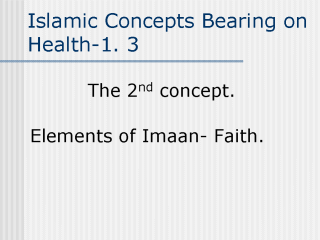| front |1 |2 |3 |4 |5 |6 |7 |8 |9 |10 |11 |12 |13 |14 |15 |16 |17 |18 |19 |20 |21 |22 |23 |24 |25 |26 |review |
 |
“The elements
of Imaan”, which means the elements of belief, faith or righteousness is the second
major concept in Islam. The elements are eloquently described in the Quran as “…It
is not righteousness that ye turn your faces towards East or West; but it is righteousness
to believe in Allah and the last day, and the angels, and the book, and the messengers; To
spend of your substance, out of love for him, for your kin, for orphans, for the needy,
for the wayfarer, for those who ask, and for the ransom of slaves; To be steadfast in
prayer, And give Zakat, to fulfill the contracts which ye have made; And to be firm and
patient, In pain (or suffering) And adversity, And through out all periods of panic, Such
are the people of truth, the god fearing” (Quran 2:177). Whereas the concept of ‘the five pillars’ is the foundation from which the Islamic lifestyle is founded on, the elements of ‘Imaan’ is its building blocks. The Prophet Muhammad (PBUH) is reported to have said: "Faith (Belief) consists of more than sixty branches (i.e. parts). And Haya (The term "Haya" covers a large number of concepts which are to be taken together; amongst them are self respect, modesty, bashfulness, and scruple, etc.) is a part of faith." On the same subject he (PBUH) is also reported to have said "A Muslim is the one who avoids harming Muslims with his tongue and hands. And a Muhajir (emigrant) is the one who gives up (abandons) all what Allah has forbidden." When the Prophet (PBUH) was asked, "Whose Islam is the best? i.e. (Who is a very good Muslim)?" He replied, "One who avoids harming the Muslims with his tongue and hands." And when asked, "What sorts of deeds or (what qualities of) Islam are good?" The Prophet (PBUH) replied, 'To feed (the poor) and greet those whom you know and those whom you do not Know” (Bukhari Volume1 Bk 2 No 8, 9, 10 and 11) This concept can be said to shape the attitudes and subjective norms of Muslims towards behavioral intention and behavior in adherence to the principals of Islam and ultimately to a healthy lifestyle. Its link towards health therefore is in two ways; firstly it reinforces religious worship and prayer which through psychodynamics of rituals can lead to feelings of relaxation, hope, contentment and positive emotions, which in turn fosters a sense of coherence as described by Antonovsky (1987) (Indirect link on the Islamic Health Continuum), secondly it highlights the importance of religious involvement and fellowship with other people so creating enabling environment for social support by encouraging social organization. Reference: Antonovsky, A. (1987). Unraveling the mystery of health: How people manage stress and stay well. 1st ed. San fransisco. Jossey-Bass Publishers Antonovsky, A. (1979). Health , Coping and Stress. 1st ed. 433 California street, San Fransisco, Califronia 94104. Jossey-Bass Inc. Khan M. M.(2001). Sahih Bukhari Translation. Muslim Student Association, University of Southern California. Web site |
| front |1 |2 |3 |4 |5 |6 |7 |8 |9 |10 |11 |12 |13 |14 |15 |16 |17 |18 |19 |20 |21 |22 |23 |24 |25 |26 |review |